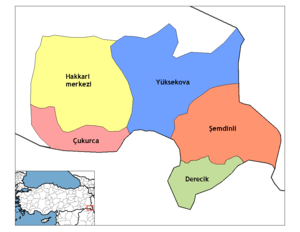Hakkâri Province
Hakkâri Province (Turkish: Hakkâri ili, Kurdish: Parêzgeha Colêmêrgê[2]), is a province in the southeast of Turkey, in Turkish Kurdistan. The administrative centre is the city of Hakkâri (Kurdish: Colemêrg[3]). The province covers an area of 7,121 km² and has a population of 251,302 (2010 est). It had a population of 236,581 in 2000. The province was created in 1936 out of part of Van Province. It borders Şırnak Province to the west, Van Province to the north, Iran to the east, and Iraq to the south. The majority of the province's population is Kurdish.[4] The current Governor is İdris Akbıyık.[5]
Hakkâri Province Hakkâri ili | |
|---|---|
 Location of Hakkâri Province in Turkey | |
| Country | Turkey |
| Region | Central East Anatolia |
| Subregion | Van |
| Government | |
| • Electoral district | Hakkâri |
| • Governor | İdris Akbıyık |
| Area | |
| • Total | 7,121 km2 (2,749 sq mi) |
| Population (2018)[1] | |
| • Total | 286,470 |
| • Density | 40/km2 (100/sq mi) |
| Area code(s) | 0438 |
| Vehicle registration | 30 |
| Website | hakkari.gov.tr |
Districts

Hakkâri province is divided into 4 districts (capital district in bold):
History
The area has been ruled by Gutians, Hurrians, Akkadians, Hittites, Assyrians, Babylon, Macedonians, Persians, Greeks, Armenians, Parthians, Rome, Byzantium, the Sassanids, Arabs, Seljuks, Mongols, and Ottomans in its long history. Despite widespread massacres of Hakkari Assyrians by Kurds in the 19th century, the region retained a mixed population of Assyrians and Kurds until the Assyrian genocide.[6] The following list concerns the Assyrian tribes that inhabited Hakkari (note: this list is incomplete):
- Jilu Tribe[6]
- Dez Tribe[6]
- Baz Tribe[6]
- Tkhuma Tribe[6]
- Tyari Tribe (Lower)[6]
- Tyari Tribe (Upper)[6]
In Turkey
In order to Turkefy the local population,[7] in June 1927 the Law 1164 was passed[8] which allowed the creation of Inspectorates-General (Umumi Müffetişlik, UM).[9] The province therefore was included in the so-called First Inspectorate General, which span over the provinces of Hakkâri, Siirt, Van, Mardin, Bitlis, Sanlıurfa, Elaziğ, and Diyarbakır.[10] The first UM was created on the 1 January 1928 and centered in Diyarbakır.[11] The UM was governed by an Inspector General, who governed with a wide-ranging authority over civilian, juridical and military matters.[9]The office of the Inspector General was dissolved in 1952 during the government of the Democrat Party.[12] Hakkari though was still banned for foreign citizens until 1965.[10]
From July 1987 to August 2002 Hakkari was within the OHAL state of emergency region.[13] It was Governed by a so called Supergovernor, who was invested with additional powers than a normal Governor. He was given authority over all the other provincial Governors in the OHAL area and also the power to permanent relocation and resettlement of the of villages population.[14]
Demographics
| Historical population | ||
|---|---|---|
| Year | Pop. | ±% p.a. |
| 1927 | 24,980 | — |
| 1940 | 36,446 | +2.95% |
| 1950 | 44,207 | +1.95% |
| 1960 | 67,766 | +4.36% |
| 1970 | 102,312 | +4.21% |
| 1980 | 155,463 | +4.27% |
| 1990 | 172,479 | +1.04% |
| 2000 | 236,581 | +3.21% |
| 2010 | 251,302 | +0.61% |
| 2018 | 286,470 | +1.65% |
| source:[15] [16] | ||
References
- "Population of provinces by years - 2000-2018". Turkish Statistical Institute. Retrieved 9 March 2019.
- "Li Colemêrgê boriyên gaza xwezayî hatin danîn" (in Kurdish). Rûdaw. 23 July 2019. Retrieved 27 April 2020.
- Kurdologie, Österreichische Gesellschaft zur Förderung der; Studien, Europäisches Zentrum für kurdische; Schmidinger, Thomas; Hennerbichler, Ferdinand; Six-Hohenbalken, Maria Anna; Osztovics, Christoph (2015-05-22). Wiener Jahrbuch für Kurdische Studien (Ausgabe 2/2014): Schwerpunkt: Die Geschichte von kurdischen Studien und Kurdologie. Nationale Methodologien und transnationale Verflechtungen (in German). BoD – Books on Demand. p. 434. ISBN 978-3-944690-32-2.
- Watts, Nicole F. (2010). Activists in Office: Kurdish Politics and Protest in Turkey (Studies in Modernity and National Identity). University of Washington Press. ISBN 9780295990507.
- "T.C. Hakkari Valiliği". www.hakkari.gov.tr. Retrieved 2020-03-26.
- Becker, Adam H. (2015). Revival and Awakening: American Evangelical Missionaries in Iran and the Origins of Assyrian Nationalism. University of Chicago Press. p. 47. ISBN 9780226145457.
- Üngör, Umut. "Young Turk social engineering : mass violence and the nation state in eastern Turkey, 1913- 1950" (PDF). University of Amsterdam. pp. 244–247. Retrieved 8 April 2020.
- Aydogan, Erdal. "Üçüncü Umumi Müfettişliği'nin Kurulması ve III. Umumî Müfettiş Tahsin Uzer'in Bazı Önemli Faaliyetleri". Retrieved 8 April 2020.
- Bayir, Derya (2016-04-22). Minorities and Nationalism in Turkish Law. Routledge. p. 139. ISBN 978-1-317-09579-8.
- Jongerden, Joost (2007-01-01). The Settlement Issue in Turkey and the Kurds: An Analysis of Spatical Policies, Modernity and War. BRILL. p. 53. ISBN 978-90-04-15557-2.CS1 maint: date and year (link)
- Umut, Üngör. "Young Turk social engineering : mass violence and the nation state in eastern Turkey, 1913- 1950" (PDF). University of Amsterdam. p. 258. Retrieved 8 April 2020.
- Bozarslan, Hamit (2008-04-17). Fleet, Kate; Faroqhi, Suraiya; Kasaba, Reşat; Kunt, I. Metin (eds.). The Cambridge History of Turkey. Cambridge University Press. p. 343. ISBN 978-0-521-62096-3.
- "Case of Dogan and others v. Turkey" (PDF). p. 21. Retrieved 12 November 2019.
- Jongerden, Joost (2007). The Settlement Issue in Turkey and the Kurds. Brill. pp. 141–142. ISBN 978-90-47-42011-8.
- Genel Nüfus Sayımları
- tuik